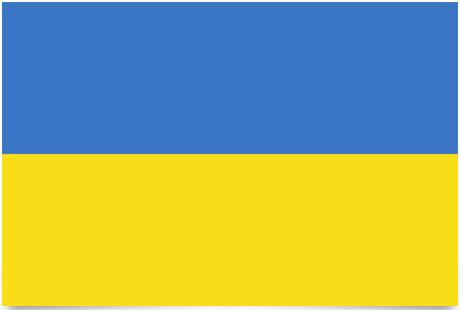Ukraine Flag and Meaning
Flag of Ukraine

Ukraine Flag Meaning
The flag of Ukraine was adopted in connection with independence at the end of the First World War but was unofficially used by several short-lived states that existed between 1917 and 1920. The flag was banned when the Red Army occupied the country and proclaimed the Soviet republic of Ukraine.
During World War II, the flag was used by Ukraine, which was then German-occupied. It was not allowed in 1945 until 1991 when it was withdrawn on September 4 of the same year. The flag is blue and yellow in two equally wide horizontal bands. Blue and gold or yellow as it is in the flag were used as the colors of the Kingdom of Kiev even before Christianity had been introduced.
Ukraine Overview
| Population | 49.6 million |
| Currency | grivna |
| Area | 603,700 km² |
| Capital city | Kiev |
| Population density | 82.1 inbound / km² |
| HDI location | 69 |
Ukraine borders Poland, Slovakia, Hungary, Romania and Moldova in the west and southwest, with Belarus in the north and Russia in the east and northeast. In the south it is adjacent to the Black Sea and the Azov Sea (Acovsko More). The landscape is mostly flat with some hill areas. In the southwest it borders the Carpathian mountains and in the south to the Crimean mountains. The country has temperate mainland climate. In the south, the land is black and covered with steppes. In the north there is mixed forestry (14% of the area). The pollution of rivers and the atmosphere is considerable. About 2.8 million people live in areas that are contaminated by Chernobyl disaster.
People: Ukrainians, 72.7%; Russians, 22.1%; Belarusians, 0.9%; molds, 0.6%, Poles, 0.4%
Religion: Russian Orthodox Christianity
Languages: Ukrainian (official), Russian, Romanian, Polish, Hungarian.
Political parties: Regions Party (Yanukovich Party); Yuliya Tymoshenko Block (consisting of: All Ukrainians united for the Fatherland, Ukraine’s Social Democracy); Viktor Yushchenko’s block, Our Ukraine (consisting of: The People’s Union of Ukraine, Ukraine’s Business and Industry Party, Ukraine’s People’s Movement, Christian Democratic Union, Republican Party, Ukraine’s National Congress); Ukraine Communist Party; Agriculture Party; Socialist Party; Women for the Future; The Greens.
Social organizations: The Confederation of Free Trade Unions in Ukraine (KVPU, consists of 18 trade unions), League of Women of Ukraine, Ukrainian National Committee for Youth Organizations (UNkmO).
Official name: Ukrayina.
Administrative division: 25 regions. The Republic of Crimea has special status with extensive internal autonomy.
Capital: Kiev (Kiev), 2,819,566 (2008).
Other important cities: Jarkov (Char’cov), 1,692,700 inb; Dniepropetrovsk (Dnemopetrovsk), 1,483,300 inb; Donetsk (Doneck), 1,764,000 in; Odessa, 1,121,500 residents (2000)
Government: Petro Poroshenko, President and Head of State since June 2014. Volodymyr Groysman, Prime Minister since April 2016. Parliament has one chamber, the Supreme Council with 445 members. 220 of these are selected in single-member circles, while 225 are selected according to a proportional system.
National Day: August 24 (Independence, 1991)
Armed Forces: 273,000 (2003).
Paramilitary forces: 72,000 (National Guard and Border Guard)













































